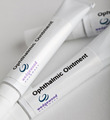Pronunciation
deye-KLO-fen-ac SO-de-um - Pronunciation guide
Brand Names
- Surpass Topical Cream
Description
 Diclofenac sodium uses a new technology called liposome delivery as a means of carrying the drug past the skin to the targeted tissue. This locally-enhanced topical delivery not only maximizes the penetration of the drug, but also sustains the drug's release in the target tissue.
Diclofenac sodium uses a new technology called liposome delivery as a means of carrying the drug past the skin to the targeted tissue. This locally-enhanced topical delivery not only maximizes the penetration of the drug, but also sustains the drug's release in the target tissue.
This topical, nonsteroidal anti-inflammatory cream is used to treat pain and inflammation by inhibiting the body's production of prostaglandin and other mediators of the body's inflammatory response.
Diclofenac sodium is also used as an ophthalmic treatment when corticosteroids are contraindicated.
Usage
With the new locally-enhanced topical delivery, diclofenac sodium is used to treat inflammation associated with osteoarthritis in the hock, knee, fetlock, and pastern joints of the horse. It also decreases soft tissue swelling in the lower leg.
As an ophthalmic, diclofenac sodium is used in the treatment of anterior uveitis, equine recurrent uveitis, traumatic and non-ulcerative keratitis, and keratouveitis. It also inhibits meiosis.
Dosage and Administration
 Cyproheptadine Cyproheptadine |
||||
|---|---|---|---|---|
| Method | Dosage (click row for calculator) |
Concentration | Period | Duration |
| Ophthalmic solution | 1 drop | 0.1% | Up to 10 days | |
| Topical | 5 inch (12.7 cm) inch ribbon | 1% | Twice daily | Up to 10 days |
Notes:
|
||||
Side Effects
When used according to directions, side effects seldom occur. Some horses may develop skin problems if the cream and environmental dirt is allowed to build up over the treated area. This problem can be avoided by regular washing with mild shampoo.
In general, NSAIDs should be carefully monitored when used in horses with liver or kidney disease or with horses that have gastrointestinal problems.
Precautions
This drug is not a hand cream and gloves should be worn during application. Package directions and veterinarian instructions pertaining to the amount applied should be followed carefully.
Young foals with health problems require careful monitoring. Use of drugs to protect the GI tract such as omeprazole, cimetidine, and sucralfate are often recommended for use with NSAIDs when treating foals.
Lower doses are often recommended for ponies and older horses, especially those with decreased kidney or liver function.
Diclofenac sodium is a prescription drug and is restricted by U.S. federal law to be used by or on the lawful written or oral order of a licensed veterinarian.
Diclofenac sodium is a regulated or prohibited substance in most sanctioned competitions. It is important to check with the individual regulatory group regarding rules and regulations.
Interactions
Avoid combining with other anti-inflammatory drugs that tend to cause ulcers, such as corticosteroids and other NSAIDs.
Overdose
Overdoses of diclofenac sodium cause more severe side effects. Early signs of toxicity include loss of appetite, weight loss, colic, and depression.
Images
 Diclofenac Sodium Eye Ointment
Diclofenac Sodium Eye Ointment
 Diclofenac Sodium Topical Cream
Diclofenac Sodium Topical Cream
Literature
